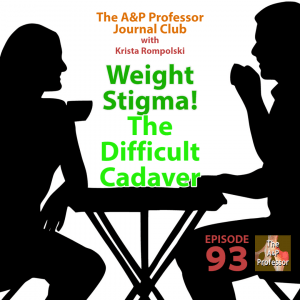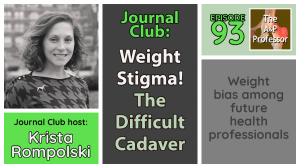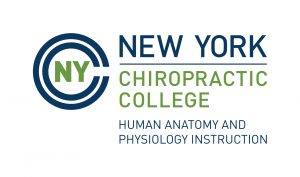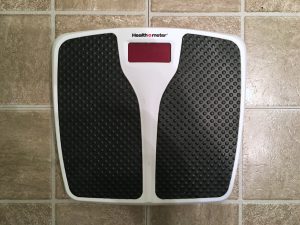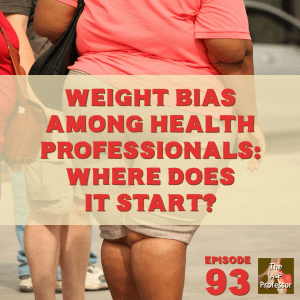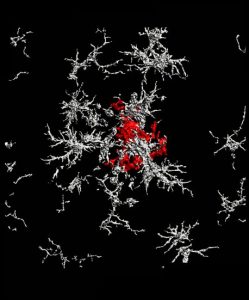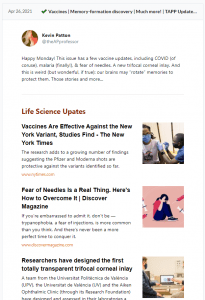Weight stigma among health professionals is a form of discrimination that can have serious consequences in the lives of people who are overweight or obese. These folks are therefore often pre-judged as being difficult patients, for example. Krista Rompolski joins us for a Journal Club episode, where we discuss a paper on how attitudes about large body donors may contribute to weight stigma among health professionals. What's going on? Is there anything we educators do to influence student attitudes? An important topic for our times, for sure!
00:00 | Introduction
01:10 | Journal Club with Krista Rompolski
03:05 | Sponsored by AAA
04:01 | The "difficult" cadaver: weight bias in the gross anatomy lab
11:43 | Sponsored by HAPI
12:31 | The Conversation Begins
29:31 | Sponsored by HAPS
30:26 | The Conversation Continues
59:46 | Staying Connected
If you cannot see or activate the audio player, go to: theAPprofessor.org/podcast-episode-93.html
Apply for your credential (badge/certificate) for listening to this episode: theAPprofesssor.org/podcast-episode-XX.html/#badge
Please take the anonymous survey: theAPprofessor.org/survey
Questions & Feedback: 1-833-LION-DEN (1-833-546-6336)
Follow The A&P Professor on Twitter, Facebook, Blogger, Revue, Tumblr, or Instagram! @theAPprofessor
Get the almost-daily TAPP Science & Education Updates
Research indicates that weight stigma can cause physical and psychological harm, and that affected individuals are less likely to receive adequate care. For these reasons, weight stigma damages health, undermines human and social rights, and is unacceptable in modern societies. (Joint international consensus statement for ending stigma of obesity)
Journal Club with Krista Rompolski
2 minutes
Krista Rompolski joins host Kevin Patton for another TAPP Journal Club episode!
Sponsored by AAA
1 minute
A searchable transcript for this episode, as well as the captioned audiogram of this episode, are sponsored by the American Association for Anatomy (AAA) at anatomy.org.
Don't forget—HAPS members get a deep discount on AAA membership!
The "Difficult" Cadaver
7.5 minutes
Krista Rompolski summarizes the essential content of this episode's journal article.
★ The “difficult” cadaver: weight bias in the gross anatomy lab (article from the journal Medical Education) my-ap.us/3yfanp1
Sponsored by HAPI Online Graduate Program
1 minute
The Master of Science in Human Anatomy & Physiology Instruction—the MS-HAPI—is a graduate program for A&P teachers, especially for those who already have a graduate/professional degree. A combination of science courses (enough to qualify you to teach at the college level) and courses in contemporary instructional practice, this program helps you be your best in both on-campus and remote teaching. Kevin Patton is a faculty member in this program. Check it out!
The Conversation Begins
17 minutes
Krista and Kevin discuss what they learned from the article and how that relates to their own experience as teachers and learners. Here are some background resources, if you want to know more about the topics discussed:
★ The Bizarre and Racist History of the BMI | Body Mass Index has been used in recent decades as a referendum on individual health. But it was never meant to be. (essay) my-ap.us/3fnmuaX
★ What We Talk About When We Talk About Fat Acceptance (public radio interview/conversation) my-ap.us/3btntoO
Sponsored by HAPS
1 minute
The Human Anatomy & Physiology Society (HAPS) is a sponsor of this podcast. You can help appreciate their support by clicking the link below and checking out the many resources and benefits found there. Watch for virtual town hall meetings and upcoming regional meetings!
The Conversation Continues
29 minutes
There is so much to say about weight bias and its origins among health professionals. Even more than we can fit into this lengthy discussion!
★ Implicit and Explicit Weight Bias in a National Sample of 4,732 Medical Students: The Medical Student CHANGES Study (the Phelan paper mentioned by Krista) my-ap.us/3wdG4wX
★ The Silent Teacher – A Conversation with Aaron Fried | Episode 29 (where Kevin discusses his wanting to be desirable body donor)
If the hyperlinks here are not active, go to TAPPradio.org to find the episode page.
★ More details at the episode page: theAPprofessor.org/podcast-episode-93.html
★ Transcript available in the transcript box: theAPprofessor.org/podcast-episode-93.html
★ Need help accessing resources locked behind a paywall? Check out this advice from Episode 32 to get what you need! https://youtu.be/JU_l76JGwVw?t=440
Take The A&P Professor experience to the next level!
★ theAPprofessor.org/community
Earn cash by referring other A&P faculty to this podcast:
★ theAPprofessor.org/refer
Tools & Resources
★ TAPP Science & Education Updates: theAPprofessor.org/updates
★ Amazon: amzn.to/2r6Qa3J
★ Text Expander: theapprofessor.org/textexpander
★ Rev.com: try.rev.com/Cw2nZ
★ Snagit & Camtasia: techsmith.pxf.io/9MkPW
★ Krisp Free Noise-Cancelling App: theAPprofessor.org/krisp
★ The A&P Professor Logo Items: https://www.teepublic.com/stores/the-a-p-professor
Sponsors
★ Transcript and captions for this episode are supported by the American Association for Anatomy | anatomy.org
★ The Human Anatomy & Physiology Society provides marketing support for this podcast | theAPprofessor.org/haps
★ Distribution of this episode is supported by NYCC's online graduate program in Human Anatomy & Physiology Instruction (HAPI) | nycc.edu/hapi
Clicking on sponsor links helps let them know you appreciate their support of this podcast!
Follow The A&P Professor on Twitter, Facebook, Blogger, Revue, Tumblr, or Instagram @theAPprofessor
The A&P Professor® and Lion Den® are registered trademarks of Lion Den Inc. (Kevin Patton)
As an Amazon Associate I earn from qualifying purchases. I may be compensated for links to sponsors and certain other links.
Click here to listen to this episode—or access the detailed notes and transcript.

